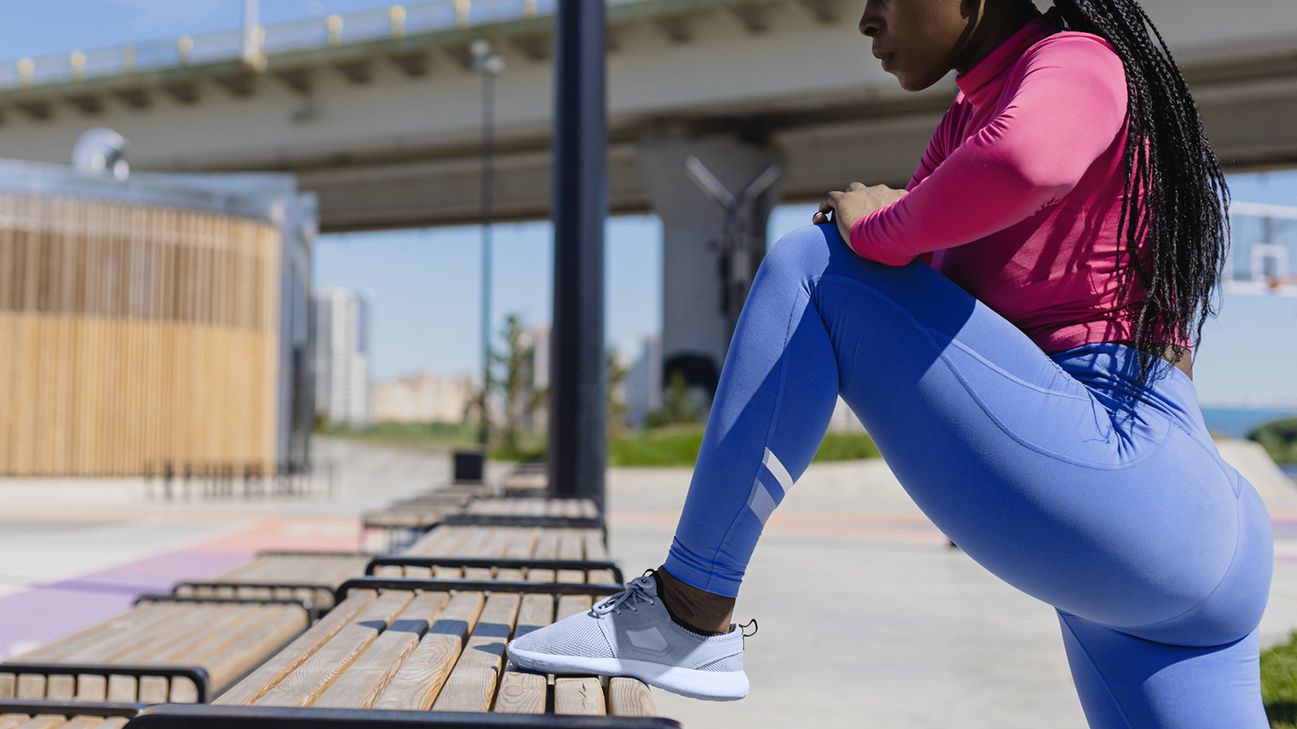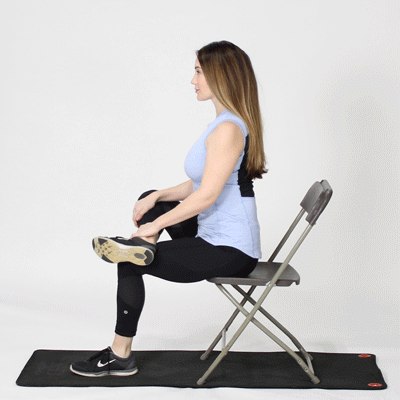Your glutes are kind of like your body’s engine. They move you forward when you walk, take you sideways when you twist, and even help you go up and down, like when you squat. But what happens when these important muscles get tight?
If you’ve been stuck for hours at your desk (or on the couch watching Netflix), your glutes can get stiff from inactivity. So, give your booty some TLC with nine of the best glute stretches out there.
9 best glute stretches
- Seated figure 4 stretch
- Seated glute stretch or twist
- Downward-Facing Dog
- Sleeping Pigeon stretch
- Knee to the opposite shoulder
- Standing figure 4 stretch
- Standing hamstring stretch
- Alternating single-leg Romanian deadlift
- Glute bridge

Your glutes are the largest muscle group in your body. They include the:
- gluteus maximus (the round part of your butt)
- gluteus medius (the side of your butt)
- gluteus minimus (the underside of your butt)
If your glutes are working overtime in back-to-back gym sessions, or they’re not getting enough time to shine during your workday, they may start to feel stiff. And if your glutes are tight, it can affect your back, hips, hamstrings, and knees.
Luckily, regular stretching is a great way to combat this problem. Stretching helps to loosen up your muscles, increases flexibility, and promotes circulation (which means more oxygen gets delivered to your muscles). It also helps prevent injury by improving your range of motion.
Try stretching your glutes at part of your pre-workout warmup to boost blood flow and prep your muscles for activity. Then, repeat the process after your workout to improve flexibility and help prevent post-exercise stiffness. Some research recommends going with dynamic stretches, but there isn’t enough evidence to know whether they’re truly more beneficial than static stretches.

Try this simple seated stretch if you need to relieve tightness in your glutes, hips, or back. It’s also helpful for dealing with sciatica.
Here’s how to do it:
- Sit tall on a chair. Bend your knees at a 90-degree angle, keeping your feet flat on the floor.
- Gently raise your right foot and place it on your left thigh. Lay your right knee to the side.
- Place your right hand on your right knee and slowly lean forward, keeping your back straight.
- When you feel resistance, stop and hold.
- Release your right leg and repeat the process with your left leg on your right thigh.
Pro tip: Can’t lay your knee straight out to the side? That’s OK! Start with your knee higher and progress from there.
This deep floor stretch helps loosen the outer glutes, hip rotators, and lower back. You can also adapt the depth of the stretch depending on how your muscles feel.
Here’s how to do it:
- Sit on the floor with both of your legs extended out in front of you.
- Keep your right leg extended on the floor, and bend your left leg at the knee until it meets your chest.
- Keep your back straight and cross your left foot over the left leg, hugging your left knee to your chest with both hands.
- Progress by placing your left arm behind you with your palm facing outward.
- Twist your body toward the left arm and position your right arm over the left knee with your palm facing outward.
- Pull the knee to increase the stretch.
- Maintain this position for up to 30 seconds if your muscles feel comfortable.
- Release the hold and repeat on the opposite side.
Pro tip: Depending on how practiced you are and how easy you find the movement, you can twist slightly or deeply. Listen to your body!
Downward-Facing Dog (aka Adho Mukha Svanasana) is a foundational and traditional yoga pose. It’s popular because it loosens and stretches a ton of muscles, including your leg muscles, glutes, and upper body, while simultaneously strengthening your arms and legs.
Here’s how to do it:
- Start in plank position on the floor.
- Place your hands shoulder-width apart, with your shoulders directly above wrists.
- Ensure your hips are above or slightly in front of knees.
- Tuck your toes under.
- Lift your knees and straighten out your legs so that your body resembles an upside-down “V” shape.
- Extend and lengthen your back while also pressing through the palms of your hands and balls of your feet.
- Hold the position for 20 to 30 seconds while remembering to breathe.
- Release and bring your knees to the floor.
Pro tip: Don’t worry if you can’t touch your heels to the floor or if your legs or arms have trouble supporting you when you first attempt this pose. Consistent practice can help you improve.
Another foundation yoga move, the Pigeon Pose or stretch, can also improve your flexibility. It helps loosen your glutes, opens your hips, and may help ease lower back pain.
Here’s how to do it:
- Start on the ground on all fours.
- Take your right knee and lay toward your right wrist, keeping shin on the floor.
- Move your right ankle toward the opposite wrist. (It’s OK if it’s a lot closer to your hip, simply go as far as you can without feeling pain.)
- Extend your left leg back while facing your hips forward and pointing toes.
- Slowly move your hands forward and extend spine.
- Hold the position for up to 10 breaths.
- Release back to the starting position.
- Switch legs and repeat.
Pro tip: Don’t let your outer hip collapse and sit flat against the ground. Use a folded blanket to support your hips, if needed.
Also called the piriformis stretch, this exercise allows you to loosen the — you guessed it — piriformis muscle. If you experience sciatica, it’s a great option to release tension while also loosening your glute muscles.
Here’s how to do it:
- Lie on your back with your legs outstretched.
- Pull the left knee toward your right shoulder and cross your left foot over your right knee.
- Hold this position where comfortable and maintain for 20 to 30 seconds.
- Gently release the leg and return to the starting position.
- Repeat with the opposite leg.
Pro tip: Only bring your knee up as far as it’s comfy. Don’t force any movement that feels too much.
Remember the seated figure 4 stretch from earlier? Well, this is its slightly more challenging cousin that also requires balance. Don’t worry, it’s worth the effort to relieve tightness in your glutes and surrounding areas.
Here’s how to do it:
- Stand up straight, lengthening your spine.
- Lift your left foot and cross the ankle over your right thigh, just above the knee. You should look something like a number four.
- As you’re standing on one leg, slowly bend your right knee to move down into a squat position.
- Feel the stretch in your left glute and hold the position for 20 to 30 seconds.
- Gently release the position and straighten your body upright while placing your leg back on the ground.
- Repeat with the opposite leg.
Pro tip: You can hold on to the wall, chair, or another steady surface for support if you need to.
This stretch is a fab warmup before a workout or while you’re cooling down afterward. It helps loosen your hamstrings, glutes, and hip flexors.
Here’s how to do it:
- Stand up straight, extending spine and keeping feet hip-width apart.
- Take your left foot forward and place heel onto the floor at a 45-degree angle from your shin.
- Exhale and lean forward.
- Feel the stretch through your hamstrings and glutes.
- Reach for the raised toes and hold them with your left hand while keeping your back straight and shoulders back.
- Hold for 20 seconds and switch legs.
- Repeat the movement and, each time, bring the stretch slightly deeper.
- Aim for 10 to 20 reps.
Pro tip: If you can’t hold your toes, just reach as far as you find comfortable.
If you need a new pre-workout move to add to your routine or want a release after a few hours of desk work, this deadlift-inspired strengthening move is the jam.
Here’s how to do it:
- Stand up and extend your spine while keeping feet hip-width apart and knees slightly bent. Place your arms at your sides.
- Shift your weight onto right leg so left leg is ready for movement.
- Hinge at the waist and bring your upper body forward and parallel to the floor. At the same time, extend your left leg straight behind you and reach for the floor with your left hand.
- Return to the starting position and switch sides.
- Repeat for 10 to 15 reps per side.
Pro tip: Keeping your spine neutral and your hips aligned is key to success with this move. This allows your glutes to lengthen and contract as they support the upper body and movement.
You can activate and strengthen your glutes with this move. It’s a strengthening move that engages the glutes while easing tightness. Plus, you’ll stretch out your hip flexors and quads as you lift.
Here’s how to do it:
- Lie on the floor on your back.
- Bend both knees, keeping feet flat on the ground.
- Cross your arms.
- Tilt pelvis up and flatten lower back.
- Press your heels into the floor.
- Lift your hips upward and engage glutes.
- Lower down and repeat 10 to 12 times.
Pro tip: Use this bridge to warm up before a workout or to activate sleepy glutes from sitting at your desk all day.
Your glutes are a group of three booty muscles that work hard to support your movement and stabilize your pelvis. If your glutes are tight, it can cause issues (and even injury) with your back, hips, and other nearby areas.
Tight glutes can happen whether you’re overusing these important muscles or underusing them. But no matter what the cause, there’s a glute stretching exercise that can help loosen ’em up and relieve tension.
Why add glute stretches to your warmup and cool-down routine to help prevent injuries and post-exercise stiffness? They’re bad-ass!

